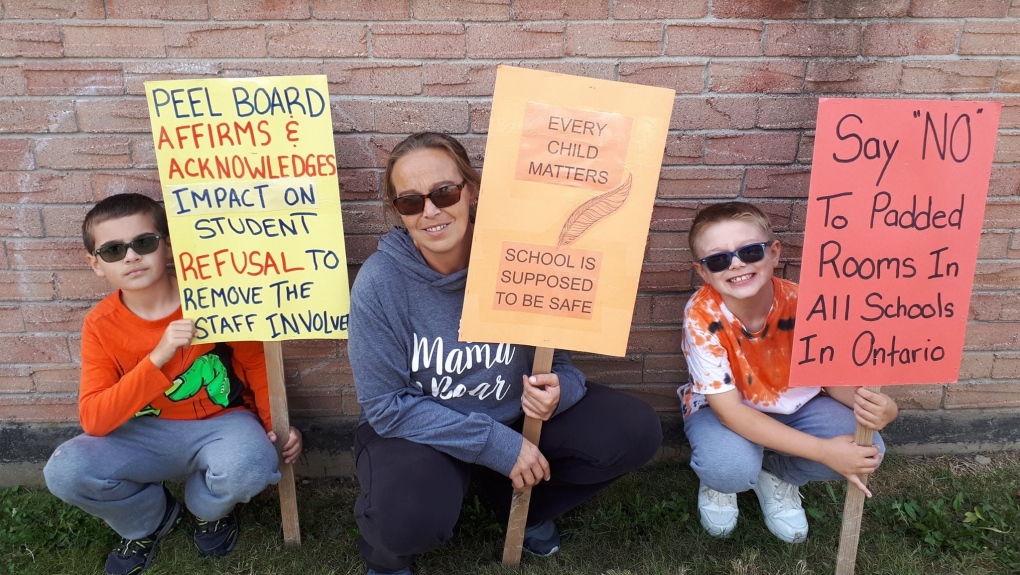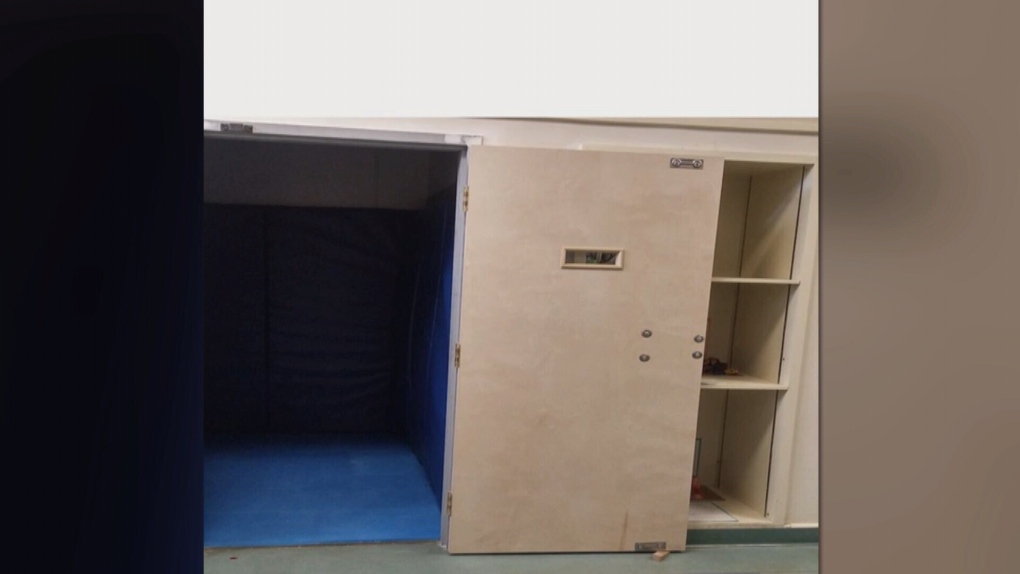Ontario mother says young son was placed in small padded room by school without her knowledge
 Margaret Hodgson is seen in this image with her two sons. (Supplied)
Margaret Hodgson is seen in this image with her two sons. (Supplied)
You can hear the discomfort in Margaret Hodgson’s voice as she describes “the room” she says her son was placed in multiple times by teachers at an Ontario school without her knowledge or consent.
“I'm horrified. Like, I didn’t know that this room existed,” Hodgson told CTV News Toronto over the phone on Thursday.
The Mississauga mother of three said all of her children live with some form of autism, but the challenges faced by her middle child have been especially difficult.
- Download our app to get local alerts to your device
- Get the latest local updates right to your inbox
“[He] has a lot more anxiety and frustration that comes with not being able to express himself,” Hodgson explained, pointing to her son's issues with communication, hearing, and short-term memory.
But it wasn’t until one year into the COVID-19 pandemic that Hodgson said she actually learned about the methods his teachers at Riverside Public School had used to keep him under control.
Hodgson said her son was struggling with remote learning and expressed his desire to return to the classroom.
“He breaks down in tears and says, ‘I don't care. I'm done. I don't want to do this [virtual] school. I want to go back to real school. I'll even go in that room that they put me in.’”
Caught off guard by the reference to a “room,” Hodgson said she began asking questions of her son -- who would have been in Grade 1 at the time.
A protocol had been established that if her son had to be “removed” from a traditional classroom, he would go to the principal’s office first, Hodgson explained. But her son began to describe a room that was different from the principal’s office.
“When I asked him what room he was talking about, he started to describe the library to me, or at least that's what I thought [he was describing].”
“So I physically walked down to the school and I said to him, ‘show me’ and he took me to the outside window of the ASD [autism spectrum disorder] contained classroom. And he pointed through the window, and I could see this door. And I was like, ‘what is that?’ and he's like, ‘that's the room,’” Hodgson recalled her son saying in March of 2021.
After making several demands to see the inside of the room herself, Hodgson said she was finally granted a guided tour two months later, accompanied by the Peel District School Board’s superintendent, the school’s principal and her son's teacher.
Hodgson described a small room with walls covered in bright, vinyl-coloured padding that she said was akin to a jail cell. In fact, she said, the padding is so thick that the only window in the room was barely useable.
She said she was not allowed to take pictures of the space.
“I can't imagine what would be going through his brain in that room. Like, he is not the kid who likes small spaces,” she explained.
As for how many times her son was placed in the room, Hodgson said he only responds by saying “lots.”
Hodgson has since removed her son from Riverside and said he’s made strides with his at-home learning, which she plans to continue indefinitely until the room is removed.
“I want him in school. That is the only place he's going to learn his social [skills]… But I am not sending him back to Riverside without the removal of that room,” she said.
PROVINCE DOESN’T TRACK USE OF ‘SECLUSION ROOMS’
According to Ontario’s Ministry of Education, the use of so-called ‘seclusion rooms’ aren’t tracked by the province.
Moreover, the Ministry says it’s up to individual school boards to determine when one of these rooms can be used and for how long.
That’s a big problem, according to autism advocate Anne Borden, who acts as a spokesperson for Autistics 4 Autistics (A4A), which is calling for a ban on seclusion rooms by way of legislation through Bill 160.
“If we can see how often this is happening, we can identify the epidemic nature of it, work further for an actual ban…But it's very hard to argue for banning the rooms, if you don't know how often they're used,” she told CTV News Toronto in an interview.
Due to the lack of data, Borden says A4A has been forced to rely on other province’s statistics to try and understand how widespread the problem might be in Ontario.
For example, in Alberta, a report by Edmonton Public Schools published in Oct. 2019 found that the seclusion rooms throughout schools in the board -- of which there are 137 -- had been used 716 times in just 19 days the month prior.
 An example of a seclusion room is seen in this image. (CTV News Edmonton)
An example of a seclusion room is seen in this image. (CTV News Edmonton)
The previous Alberta NDP government had actually announced a ban on the use of the rooms which was set to take effect in the 2019-2020 academic year. The incoming UCP government reversed the ban but did introduce new measures to limit and track their use.
Alberta Education Minister Adriana LaGrange said at the time, “Seclusion and physical restraint are tools of last resort. I applaud school divisions that are looking for ways to limit their use, and are even working towards their elimination."
Borden believes that with those statistics in mind, “you could extrapolate from that our provinces are not that different” and, just like Alberta, seclusion rooms in Ontario are “often used not as a last resort, but as a first resort.”
Former MPP Michael Coteau tabled Bill 160 back in Dec. 2019, but its path through the legislature was stalled by the COVID-19 pandemic and Coteau’s departure from provincial politics.
IS THERE AN ALTERNATIVE?
While the goal of A4A and other autism advocates is to see seclusion rooms done away with entirely, Borden said a cornerstone of the alternative approach to teaching children with autism is something called trauma-informed care.
“A trauma-informed approach allows teachers to be able to take a breath, and prevent situations from escalating. it also allows them to de-escalate someone when that person is upset,” she said.
“What's happening now, in a lot of these classrooms -- the classrooms that use these [seclusion rooms] -- is that teachers are escalating conflicts with their own anger. When a little six-year-old kid is put into a seclusion room, it's because the person, the adult, couldn’t control themselves.”
In an email to CTV News Toronto, a spokesperson for Peel District School Board said some of its schools, including Riverside Public School, have “alternative learning environment calming/de-escalation rooms.”
“Which can be a room with cushioned walls, floors, and doors for safety. Peel District School Board has 61 schools with these features in a room,” the board said in a statement.
Although the rooms can be accessed voluntarily by students, the board said that in certain situations, where a student needs to be temporarily separated from the classroom for safety reasons, “the room may be used for de-escalation.”
The board went on to say that when a room is used for the purposes of de-escalation, it must involve an intervention plan developed collaboratively through the student review process in consultation with a psycho-educational consultant and parents and must be documented in the student’s individual education plan and safety plan.
Those plans, also known as IEPs, allow school boards to work with parents directly on learning approaches that the Ministry of Education believes are effective in supporting student’s needs.
CTVNews.ca Top Stories

Statistics Canada reports real GDP grew 0.3 per cent in October
Statistics Canada says the economy grew 0.3 per cent in October, helped by strength in the mining, quarrying, and oil and gas extraction sector, following a 0.2 per cent increase in September.
Trump again calls to buy Greenland after eyeing Canada and the Panama Canal
First it was Canada, then the Panama Canal. Now, Donald Trump again wants Greenland.
LIVE UPDATES Parts of Ontario under snowfall warning Monday as holiday travellers hit the road
Holiday travellers and commuters could be in for a messy drive on Monday morning as a significant round of snowfall moves into the region. Here are live updates on the situation in Toronto.
King Charles ends royal warrants for Ben & Jerry's owner Unilever and Cadbury chocolatiers
King Charles III has ended royal warrants for Cadbury and Unilever, which owns brands including Marmite and Ben & Jerry’s, in a blow to the household names.
U.S. House Ethics report finds evidence Matt Gaetz paid thousands for sex and drugs including paying a 17-year-old for sex in 2017
The U.S. House Ethics Committee found evidence that former Rep. Matt Gaetz paid tens of thousands of dollars to women for sex or drugs on at least 20 occasions, including paying a 17-year-old girl for sex in 2017, according to a final draft of the panel's report on the Florida Republican, obtained by CNN.
The rent-a-friend industry is booming among Canada's Chinese diaspora
Dozens of people are offering rent-a-friend services on Xiaohongshu, a social media platform also known as Little Red Book or China's Instagram, in cities including Vancouver, Calgary and Toronto.
Dozens of luxury condos and hotels in Florida are sinking, study finds
Dozens of luxury condos, hotels and other buildings in southeast Florida are sinking at a surprising rate, researchers reported in a recent study.
Nordstrom agrees to US$6.25B buyout deal from founding family
Nordstrom said on Monday it would be acquired by its founding family and Mexican retailer El Puerto de Liverpool in an all-cash deal valuing the department store chain at about US$6.25 billion.
Biden gives life in prison to 37 of 40 federal death row inmates before Trump can resume executions
U.S. President Joe Biden announced on Monday that he is commuting the sentences of 37 of the 40 people on federal death row, converting their punishments to life imprisonment just weeks before president-elect Donald Trump, an outspoken proponent of expanding capital punishment, takes office.
































